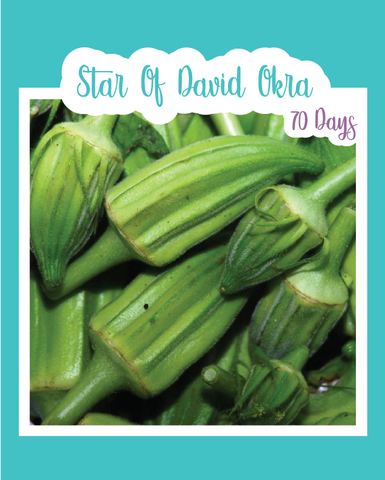
Clemson Spineless Okra
Seed Count: Approx. 40 seeds
Days to Maturity: 56 days
Description: Clemson Spineless okra was the 1939 All-American selections winner, and is still the most popular variety on the market. This old time favorite is perfect breaded and fried, in soups, relishes, stews, and gumbos. The tasty, dark green, ribbed fruits grow on 4-7 ft. plants that also make a few side branches. The pods can grow up to 9 inches long, however, it's best to pick them while young and tender. Okra is extremely nutritious, fiber rich, and loaded in nutrients. It has been known to be beneficial to pregnant women, to control blood sugar, and good for heart health. Its cream colored flowers not only make this plant ornamental, but they are also edible! This variety is spineless, which makes it super easy and painless to harvest. Okra is known to be grown in Southern warm climates, but it can easily be grown just about anywhere. This popular home garden variety can also be grown in containers!
Mint2Grow Tip: Pick okra often, while pods are young, up to 3 inches long, to keep the plant nice and productive. I love to eat okra stir fried in a little soy sauce and sesame oil, but my favorite way to eat okra is the sinful, deep fried, Southern way, served with a zesty sauce.
How To Grow
Sowing: Okra loves heat, so growers with short growing seasons will need to start their seeds indoors. Set seeds outside, about 3-4 weeks after the last frost. Before planting your seeds, soak them overnight; this can help with faster germination, however, I never bother. Plant 2-3 seeds in one peat pot, and keep them at 80-90 degrees F until they germinate. Thin to the strongest seedling by cutting off the rest of the plants at their bases. When the air temperature reaches a consistent 60 degrees F, you can harden off your seedlings and plant them in full sun, 12-15 inches apart in rows 3 ft. apart. For direct sowing, in warmer climates, sow the seeds 3/4" deep; later thinning the plants to 12-15" apart.
Growing: When your seedlings reach a height of 4 inches, apply mulch to conserve moisture and control weeds, and keep plants moist during dry weather. In cooler climates, it may be necessary to apply black plastic or provide row covers so that your okra get the adequate heat that they require to thrive. These plants get pretty tall, so make sure you don't plant them where they'll block plants that enjoy a lot of sun. Okras do, however, make amazing windbreaks, since they are such sturdy plants. Companion plant Okra with peppers to shield them from the wind, because peppers are much more fragile. In turn, peppers repel cabbage worms from okra plants. Melons, cucumbers, and eggplants also make for great companion plants.
Harvesting: Okra is best and most tender when its younger, around 3 inches, when the seeds haven't gotten the chance to grow too big. It can be harvested at any length up to 7". When saving seed from okra, keep mind mind that it will cross pollinate with other varieties of okra and should be separated from them. Allow the pods to fully mature, and cut them off after they start to dry; if they begin to split, cut them immediately to prevent seed loss. (I like to tie mesh bags around mine to prevent this). Twisting the pods or putting them in a bag and applying pressure should remove the seed. Spread the seed out to dry for a week, then store in a cool dry place for up to 2-3 years.



